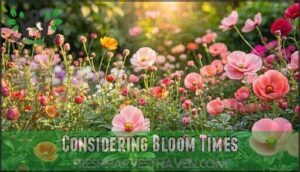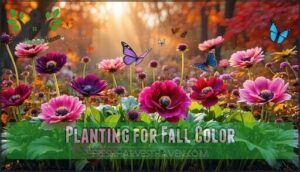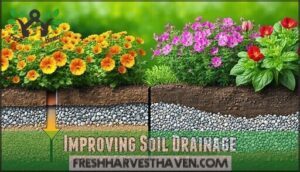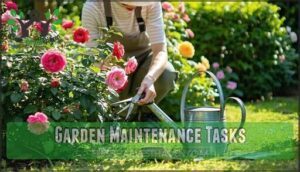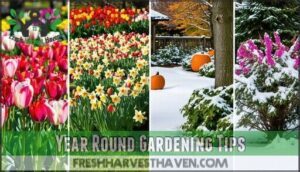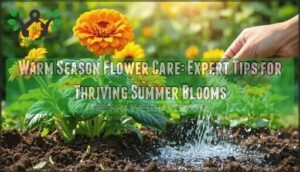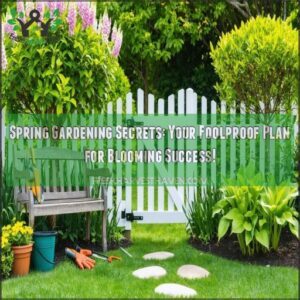This site is supported by our readers. We may earn a commission, at no cost to you, if you purchase through links.
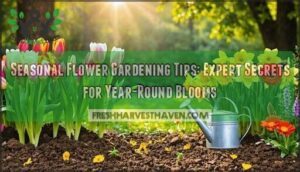 You’ll master seasonal flower gardening tips by thinking like nature’s choreographer.
You’ll master seasonal flower gardening tips by thinking like nature’s choreographer.
Start with soil that drains well and choose plants that bloom at different times.
Plant tall flowers in back, medium ones in middle, and short varieties up front.
Spring calls for cool-season pansies and snapdragons.
Summer loves heat-tolerant marigolds and zinnias.
Fall brings warm-toned mums and asters.
Don’t forget winter interest with evergreen foliage.
Test your soil’s pH first – most flowers prefer slightly acidic conditions.
Water deeply but less often to encourage strong roots.
The secret lies in understanding each season’s unique rhythm and your garden’s specific needs.
Table Of Contents
- Key Takeaways
- Seasonal Garden Planning
- Flower Selection Tips
- Soil Preparation Methods
- Garden Maintenance Tasks
- Year Round Gardening Tips
- Frequently Asked Questions (FAQs)
- What is the gardening 3 year rule?
- How to plant a flower garden for all seasons?
- What is the rule of 3 in gardening?
- What is the best fertilizer for seasonal flowers?
- When should you plant seasonal flowers?
- What month should you start a flower garden?
- How do I layout my flower garden?
- How do you make a flower garden that blooms all year?
- How often do you water seasonal flowers?
- How do I save seeds from my garden flowers?
- Conclusion
Key Takeaways
- You’ll create year-round color by choosing plants with staggered bloom times – plant spring bulbs in fall, select summer heat-lovers like marigolds, and include fall bloomers like mums and asters for continuous displays.
- Test your soil’s pH and drainage before planting since most flowers prefer slightly acidic conditions between 6.0-7.0, and poor drainage will kill your plants faster than anything else.
- Layer your garden design with tall flowers in back, medium varieties in the middle, and short plants up front, then group them in odd numbers (threes or fives) for the most natural look.
- Water deeply but less frequently to encourage strong root development, and deadhead spent blooms weekly to redirect the plant’s energy into producing new flowers instead of seeds.
Seasonal Garden Planning
You’ll save time and avoid costly mistakes when you plan your garden before the first seed goes in the ground.
Smart seasonal planning means checking your soil condition, selecting plants that thrive in your climate, mapping out your garden layout, and gathering the right tools for each season’s tasks.
This approach allows for efficient use of resources and minimizes potential issues, ensuring a successful gardening experience.
Assessing Soil Condition
Understanding your soil’s personality sets the foundation for seasonal flower success. Your garden’s health starts beneath the surface, where roots meet reality.
Your garden’s story begins underground, where hidden soil secrets determine surface success.
Proper soil assessment reveals what your flowers need to thrive year-round. You can’t fix what you don’t measure, so testing becomes your roadmap to blooming success.
Start with these essential soil health checks:
- Soil pH testing – Most flowers prefer slightly acidic to neutral conditions between 6.0-7.0
- Drainage testing – Dig a hole and fill with water to check absorption rates
- Soil texture analysis – Roll moist soil between fingers to determine clay, sand, or loam content
- Nutrient levels assessment – Use soil testing kits to identify nitrogen, phosphorus, and potassium levels
- Compaction issues evaluation – Push a screwdriver into soil to detect hard-packed areas
These soil conditions directly impact root development and flower production. Using a reliable pH meter is essential for accurate readings. Professional soil testing provides detailed nutrient analysis, but basic home tests work well for soil preparation. Address any issues before planting season arrives.
Choosing Right Plants
With your soil assessment complete, plant selection becomes your garden’s foundation.
Check Plant Hardiness zones first – you can’t fool Mother Nature with wishful thinking.
Match Sunlight Needs to your yard’s reality: full sun lovers like sunflowers won’t thrive in shade.
Consider Water Requirements and Mature Size before falling for that cute seedling.
Soil Preference matters too – some flower types prefer sandy drainage while others need rich loam.
Smart plant varieties choices make seasonal flower gardening feel effortless instead of exhausting.
Creating Garden Layout
Once you’ve chosen your plants, it’s time to sketch your garden layout on paper. Start by mapping sunny and shady areas, then create focal points with height-layered plantings.
Place tall flowers in back, medium bloomers center stage, and compact varieties up front for stunning garden design. Plan curved bed shapes instead of straight lines for natural appeal.
Smart space utilization means designing garden pathways wide enough for wheelbarrows. Group odd numbers of plants together for visual impact – plant grouping in threes or fives looks most natural.
Consider plant compatibility when arranging your flower garden ideas.
Preparing Garden Tools
Clean garden tools are a gardener’s best friend. Start your cleaning tools routine by scrubbing off last season’s dirt and plant debris.
Sharpening blades on pruners and shears makes every cut precise and prevents plant damage. Don’t forget handle maintenance – sand rough spots and apply linseed oil to wooden handles.
For rust prevention, wipe metal parts with light oil before storage. Proper tool storage in a dry location extends tool life substantially.
Consider using durable gardening gloves to protect your hands. Add garden tools maintenance to your garden checklist – your plants will thank you with healthier growth.
Flower Selection Tips
Picking the right flowers for your garden doesn’t have to feel overwhelming when you understand a few basic principles about timing and plant types.
You’ll create a stunning display that blooms from spring through fall by choosing a mix of annuals for instant color and perennials that return each year with different flowering schedules.
Choosing Annuals and Perennials
Planning your garden layout sets the stage for smart flower choices. Annuals vs Perennials shapes your entire gardening strategy. Annual flowers like petunias deliver non-stop color but need yearly replanting. Perennial flowers return each spring, offering long-term value despite shorter bloom time windows.
Consider sunlight needs and soil preferences when selecting plants. Bloom duration varies substantially between types, affecting your seasonal flowers display.
- Picture walking through your personal flower paradise every morning
- Feel the satisfaction of nurturing plants that greet you year after year
- Experience the joy of vibrant blooms brightening even ordinary days
- Imagine neighbors stopping to admire your flower gardening success
- Celebrate creating aesthetic combinations that reflect your unique style
Selecting Plants by Color
Once you’ve decided between annuals and perennials, color becomes your garden’s secret weapon. Color Harmony isn’t just pretty—it’s strategic. You’ll want to think like an artist when selecting your seasonal flowers.
Monochromatic Gardens using whites, creams, and silvers create stunning elegance. Picture white peonies beside cream roses and silver artemisia. Vibrant Contrasts work differently—purple salvia paired with yellow marigolds creates eye-popping drama that stops people in their tracks.
Seasonal Palettes shift throughout the year. Spring loves soft pastels, while fall demands warm oranges and deep reds. Color Psychology matters too—blues calm the mind, while reds energize spaces. Certain varieties like marigolds offer pest control benefits, too.
| Color Scheme | Best Combinations | Season |
|---|---|---|
| Complementary | Purple + Yellow, Blue + Orange | All seasons |
| Analogous | Red + Orange + Pink | Summer/Fall |
Smart flower gardening means understanding how garden color impacts mood and creates vibrant colors that enhance your flower varieties.
Considering Bloom Times
Most perennials put on their show for just 2-3 weeks, so Strategic Planting becomes your secret weapon.
Map out bloom times on a calendar to create Staggered Blooms that keep color flowing.
Choose early spring blooms like daffodils, mid-season summer blooms like daylilies, and late performers like asters.
This flower gardening approach maximizes Bloom Duration while you Fill Gaps naturally.
Smart Bloom Extension means your flower season never skips a beat.
Planting for Fall Color
Fall bloomers transform your garden into a masterpiece when summer flowers start fading. These hardy performers bring rich colors and foliage contrast that’ll make your seasonal shift shine.
Start planting fall flowers in late summer for peak late-season interest that lasts until frost.
Create stunning autumn displays with these fall gardening favorites:
- Hardy mums in deep burgundy and golden bronze for classic autumn warmth
- Japanese anemones with delicate pink blooms swaying in cool breezes
- Ornamental kale featuring purple-tinged leaves that deepen with cold weather
- Purple asters creating starry clusters that attract migrating butterflies
- Sedum varieties offering succulent textures and rosy-pink fall blooms
Your flower planting timing matters most for successful bloom time results, ensuring a beautiful display of fall flowers with rich colors and foliage contrast.
Soil Preparation Methods
You’ll need to prepare your soil properly if you want your flowers to thrive through every season.
Good soil preparation creates the foundation for healthy plants that bloom consistently from spring through fall.
Amending Soil With Organic Matter
After selecting the perfect flowers for your garden, your soil needs some love to help them thrive. Think of organic matter as a vitamin-packed meal for your plants.
Compost Benefits shine when you work aged compost into your garden soil preparation routine. Spread 2-3 inches deep and mix it into the top 6 inches of existing soil. Manure Types like well-aged cow or chicken manure boost soil health naturally.
Green Manure from Cover Crops like clover works magic too. Plant them in empty spots, then till them under before they flower. This improves Soil Structure while adding nutrients.
For those seeking readily available options, consider purchasing quality compost.
| Organic Matter Type | Best Time to Add | Key Benefit |
|---|---|---|
| Aged Compost | Spring/Fall | Slow nutrient release |
| Worm Castings | Anytime | Gentle soil enrichment |
| Leaf Mold | Fall | Improves water retention |
| Well-aged Manure | Fall preparation | Rich nitrogen boost |
| Garden Compost | Year-round | Complete soil amendment |
Your soil will thank you with healthier, more vibrant blooms.
Improving Soil Drainage
Waterlogged soil spells disaster for your flower garden, but fixing drainage issues isn’t rocket science.
Test your soil by digging a 12-inch hole and filling it with water—if it sits for over 24 hours, you’ve got problems.
Transform soggy spots with these proven methods:
- Install French Drains with drainage pipes to redirect excess water
- Use soil aeration techniques like core aeration to break up compacted areas
- Build Raised Beds for chronically wet locations
- Focus on amending clay soil with coarse sand and organic matter
These improvements create healthier soil conditions for thriving blooms, which is the key to a successful flower garden with thriving blooms.
Using Compost and Mulch
After getting your drainage right, it’s time to feed your soil with compost and mulch. These soil superheroes work together to create the perfect growing environment for your flowers.
Start with a 2-inch layer of compost each spring. Work it gently into the top few inches of soil for maximum soil enrichment. This organic matter boosts nutrients while improving soil structure.
Next comes mulching for water retention and weed control. Here’s your mulch selection guide:
| Mulch Type | Best Application |
|---|---|
| Wood chips | Perennial flower beds |
| Straw | Vegetable gardens |
| Pine needles | Acid-loving plants |
| Shredded leaves | Budget-friendly option |
Follow proper application techniques by spreading mulch 2-3 inches thick around plants. This garden maintenance step transforms ordinary soil into a thriving foundation.
Garden Maintenance Tasks
You’ll need to stay on top of regular garden maintenance to keep your flowers healthy and blooming throughout the growing season.
These essential tasks include proper watering, timely deadheading, pest control, and using natural solutions that’ll save you time while protecting your plants, which involves regular maintenance.
Watering and Irrigation
Smart watering techniques make the difference between thriving flowers and struggling plants.
You’ll master soil moisture by checking two inches deep with your finger.
Seasonal adjustments to your watering schedules keep plants happy year-round.
Here are five essential water conservation strategies:
- Install drip irrigation systems for targeted, efficient delivery
- Water deeply but less frequently to strengthen root development
- Schedule morning sessions to minimize evaporation losses
- Apply mulch around plants for natural moisture retention
- Monitor water needs based on weather and plant growth stages
These systems guarantee efficient water distribution directly to the roots.
Deadheading and Pruning
Proper watering sets the foundation, but deadheading and pruning keep your flowers performing like champions.
Sharp, clean garden tools make all the difference when you deadhead roses and tackle flower maintenance tasks. Tool sterilization between cuts prevents disease spread while encouraging reblooming throughout the season.
Master these pruning techniques for healthier plants:
- Cut spent blooms just above the next leaf node or bud
- Remove dead foliage weekly to prevent fungal problems
- Shape plants by pinching growing tips for bushier growth.
Regular flower care through strategic removing dead foliage redirects energy into fresh blooms instead of seed production.
Controlling Pests and Diseases
The key to pest control starts with identifying pests early through daily garden walks.
Look for aphids clustering on stems or spider mites creating fine webs.
Organic pesticides like neem oil tackle most flower pests safely.
Disease prevention means watering at soil level and providing proper plant spacing.
Employing preventative measures such as crop rotation can also minimize pest infestations.
Pest/Disease Natural Treatment
Integrated management combines multiple approaches for lasting results.
Using Beneficial Nematodes
Chemical pest control can harm your garden ecosystem, but beneficial nematodes offer a smarter approach. These microscopic allies hunt down grubs, thrips, and other soil-dwelling troublemakers without touching your precious blooms.
As an organic method, beneficial nematodes are safe for humans, pets, and plants.
Perfect nematode application requires timing and technique:
- Choose correct nematode types – Steinernema for grubs, Heterorhabditis for root weevils
- Apply during cool mornings – soil temps between 55-90°F work best
- Saturate soil beforehand – moisture helps nematodes move through earth
- Spray gently – high pressure kills these delicate warriors
- Maintain dampness – keep soil moist for two weeks post-application
This biological pest control method strengthens soil health while supporting organic gardening principles.
Year Round Gardening Tips
You can enjoy continuous blooms throughout every season by planning your garden with flowers that bloom at different times of the year.
This approach guarantees your garden stays colorful and vibrant from spring’s first bulbs through winter’s evergreen structure.
Planting Spring Bulbs
After keeping your garden healthy with regular maintenance, fall brings the perfect opportunity to plant spring bulbs that’ll wake up your yard when winter finally loosens its grip. Think of bulbs as nature’s alarm clocks – they know exactly when to ring.
Spring gardening success starts with timing. Plant your bulbs about six weeks before hard frost hits your area. Bulb depth matters more than you’d think – dig holes three times deeper than the bulb’s height for best results.
- Choose spring flowers with different bloom times for extended color shows
- Check sunlight needs for each variety before selecting planting spots
- Verify proper soil drainage to prevent bulbs from rotting over winter
- Follow consistent watering bulbs schedules during fall planting season
- Plan post-bloom care by letting foliage die back naturally each spring
Your planting efforts this fall create stunning spring displays that’ll brighten those dreary late-winter days.
Summer Flower Care
After your spring bulbs have finished their show, summer flowers take center stage and need your attention to thrive in scorching weather.
Your summer blooms face heat stress daily, so master these watering techniques: water deeply at dawn using soaker hoses. This method beats evaporation and keeps roots happy. Apply mulch around plants for cooling protection.
Deadheading tips matter most—snip spent flowers weekly to trigger new blooms. For pest management, spray neem oil on trouble spots.
Feed heat-loving flowers like zinnias with bloom boosters monthly during peak summer gardening season. To prevent moisture loss, consider organic mulch application.
| Summer Care Task | Best Timing |
|---|---|
| Deep watering | Early morning (6-8 AM) |
| Deadheading flowers | Weekly inspection |
| Pest treatment | Evening application |
| Fertilizer feeding | Monthly schedule |
| Mulch checking | Bi-weekly maintenance |
Preparing for Fall Gardening
Fall garden preparation sets the stage for next year’s success.
Complete your garden cleanup by removing diseased plants and debris.
Focus on Fall Soil Prep by adding compost and testing pH levels.
Plant Cool-Season crops like kale and spinach now.
Your garden checklist should include Tool Maintenance – clean and oil pruners before storage.
Start Seed Saving from your best performers for future seasons.
Winterizing The Garden
Winter’s harsh grip demands smart protecting plants strategies.
Apply 2-3 inches of mulch application around plant bases after nighttime temperatures drop below 50°F.
Complete thorough garden cleanup by removing diseased materials and debris.
Reduce winter watering frequency while maintaining moisture for evergreens.
Organize tool storage areas and clean equipment properly.
Your garden assessment and winter gardening checklist guarantees garden insulation and frost protection success.
Frequently Asked Questions (FAQs)
What is the gardening 3 year rule?
While some plants dazzle immediately, others take time to establish roots.
The gardening 3-year rule means you’ll wait three years for perennials to reach full maturity and peak performance in your garden beds.
How to plant a flower garden for all seasons?
Choose perennials with staggered bloom times to guarantee continuous color year-round.
Plant spring bulbs in fall, select long-blooming varieties like daylilies, and incorporate evergreens for winter interest.
While planning succession plantings, ensure to incorporate these elements to achieve a visually appealing garden throughout the year.
What is the rule of 3 in gardening?
You might think grouping plants sounds complicated, but it’s actually simple. The rule of 3 means planting flowers in odd-numbered clusters—3, 5, or 7—for maximum visual impact and natural-looking garden design.
What is the best fertilizer for seasonal flowers?
Balanced fertilizers with equal N-P-K ratios work best for most seasonal flowers.
You’ll want to feed spring bloomers with slow-release granules, while summer annuals thrive with liquid fertilizer every two weeks for continuous blooms.
When should you plant seasonal flowers?
You’ll want to plant seasonal flowers based on your local frost dates and specific flower types.
Spring flowers go in after the last frost, while fall varieties need 6-8 weeks before the first expected freeze, which is a complete concept to consider for planting.
What month should you start a flower garden?
Starting your flower garden doesn’t have to feel like rocket science.
You’ll want to begin in late winter or early March for most regions, giving cool-season flowers time to establish before summer’s heat arrives.
How do I layout my flower garden?
Plan your flower garden by grouping plants in odd numbers like threes or fives.
Layer different heights with tall plants in back, medium in middle, and short in front.
Consider continuous color throughout seasons by planning for bloom times.
How do you make a flower garden that blooms all year?
Creating a garden that dances through seasons isn’t rocket science.
You’ll plant spring bulbs in fall, choose perennials with staggered bloom times, and include long-flowering varieties like coneflowers to keep color flowing year-round.
How often do you water seasonal flowers?
You’ll water seasonal flowers based on their needs and weather conditions.
Spring and fall flowers need moderate watering, while summer blooms require daily deep watering.
Winter flowers need minimal water to prevent root rot.
How do I save seeds from my garden flowers?
Wait until flowers fully mature and pods turn brown before harvesting.
Cut stems on a dry day, then hang bunches upside down in a cool, dark place.
Once completely dry, shake out seeds and store them properly.
Conclusion
Mastering seasonal flower gardening tips transforms your outdoor space into a living masterpiece that evolves throughout the year.
You’ve learned to work with nature’s rhythm, selecting plants that thrive in each season while maintaining healthy soil and proper care routines.
Remember that successful gardening comes from understanding your local climate, testing soil conditions, and choosing varieties that complement each other.
With consistent effort and these proven techniques, you’ll enjoy continuous blooms from spring’s first shoots through winter’s evergreen beauty, and this will help you to work with nature’s rhythm and maintain healthy soil.
- https://www.octoen.com/en/blog/how-to-garden
- https://www.gardeners.com/how-to/growing-annual-flowers/5070.html?srsltid=AfmBOop_NOVXBbfcS5eR2W7v7VsPZ61luOmtRU7S25e7nn7n6g1hlqAo
- https://www.sierraflowerfarm.com/blog/2020/1/26/demystifying-when-to-seed-start-start-for-the-flower-farmer
- https://www.johnnyseeds.com/growers-library/flowers/flower-farming/succession-planting-flowers-planning-frequency-recordkeeping-tips.html?srsltid=AfmBOop5zmUBL4VgnGqtZ_5uDKAR6fGGHGMvnYm0NcUTJ_FtHeTcUzqL
- https://www.farmstandapp.com/61353/7-ways-to-maintain-a-planting-schedule-efficiently/



